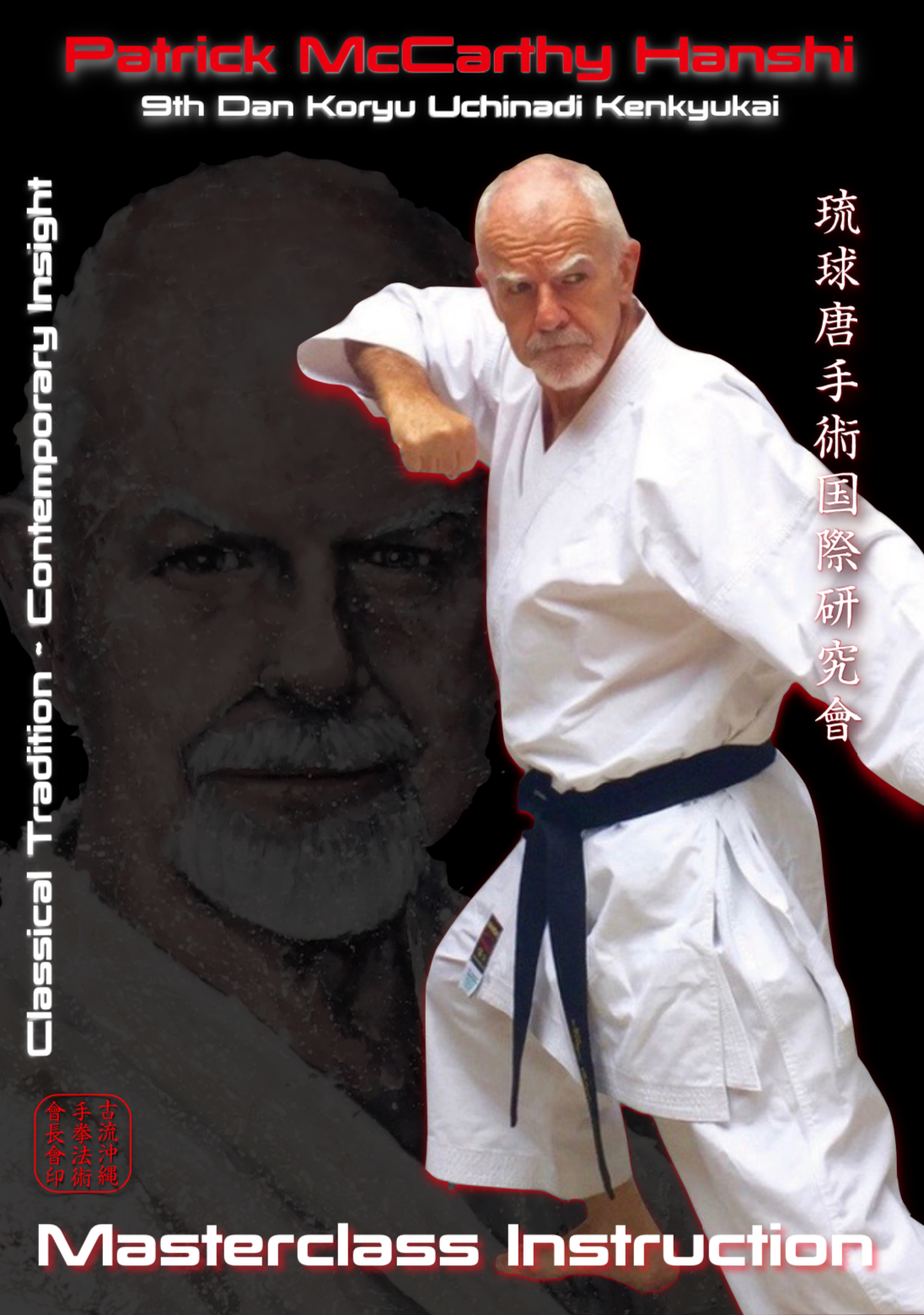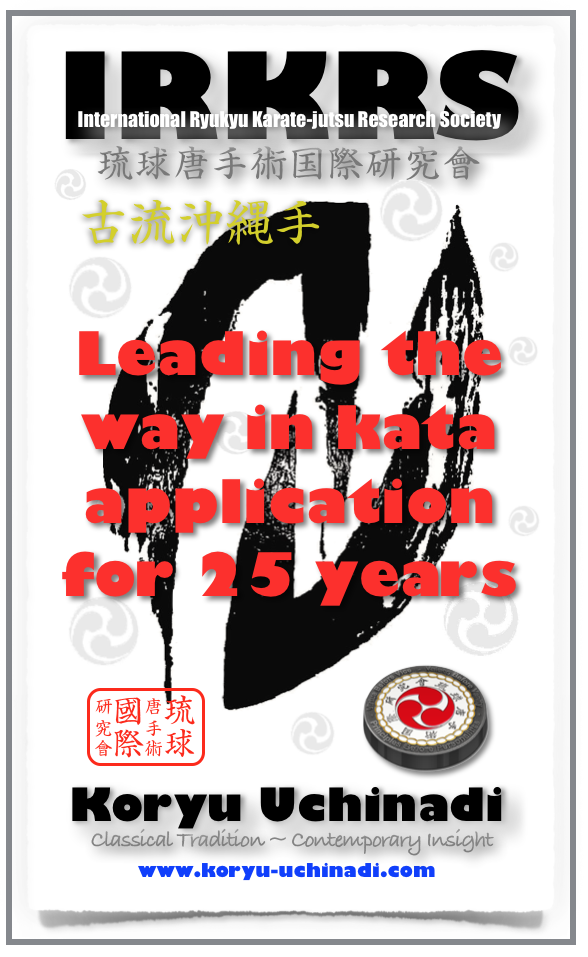Unless asked to focus upon special learning targets [i.e. … specific Kata, groundwork, apparatus-based training, Yamane Ryu Kobudo, etc.] much of what qualified KU instructors teach at seminars surround the study of KATA, in the way, we believe, it was meant to be originally understood: i.e. Conceptual philosophy ~ HAPV Scenario ~ 2-Person Application Drills ~ Venturing Outside the Comfort Zone ~ Solo Re-enactment Practice, etc. Kata, that is to say, “template-based learning,” is the one common thread weaving together the very fabric of this art and, from an application point of view, remains “style-free,” dealing exclusively with the HAPV [which do NOT discriminate].
HAPV-Theory
The acronym, “HAPV” stands for the, HABITUAL ACTS of PHYSICAL VIOLENCE. It is the systematized contextual premise, from which non-lethal empty-handed [one-against-one] self-defense practices can be applied to, in a domestic environment [in contrast to the rule-bound sporting arena, multiple/gang-related violent scenarios and or the “battlefield, etc.]
See more here http://www.koryu-uchinadi.org/KU_HAPV.pdf
Pedagogical Abstract
Individual HAPV are identified, described in detail and studied [so that the learner comes to understand its mechanics, the principles that make it work, why it’s dangerous and how it can be effectively negotiated] before being recreated in Futari-geiko/二人稽古 [i.e. 2-person drills ~ see here tinyurl.com/zymx2f3].
In 2-person drills, the attacker recreates the HAPV, with passive resistance [i.e. learning speed] while the defender rehearses its corresponding defensive theme. The exercise is continued on until the learner gains familiarity with the practice. This is to say that the learner can now progress to the next level after feeling comfortably proficient: If only in the reenactment process.
In stage number two, the attacker is required to gradually-to-exponentially increase the intensity of the attack until such time that each engagement is virtually equal to the brutality of a real scenario and any/all glitches in defender’s ability to effectively use the defensive template are resolved.
In level number three line-drills [i.e. working back and forth with various other partners; e.g. big, small, young, old, male, female, fast, hard, compliant and non-compliant, etc.] are continually used in subsequent training in order to take the learner outside their normal comfort zone.
This is the stage of practice where much discovery is unveiled about, “Murphy’s Law” [Anything that can go wrong, will go wrong], the brutality of physical violence, and the constant variables that surround function and competency. As the learner arrives at a functional understanding the training experience is culminated mnemonically; i.e. saving the defensive theme [for the exampled HAPV] into a solo reenactment practice or ritualized template [Kata/型].
Kata
By linking together such ritualized templates into choreographed solo- routines, clearly something greater than the sum total of their individual parts becomes evident … in this light, it is our belief that, “Kata was never meant to teach anything but rather, culminate the lessons already imparted [in 2-person drills].” When the contextual premise is NOT present, or is misunderstood, and/or not supported by functional scenario-based 2-person drills [i.e. the “lost formula”] that Kata becomes something different from what it was originally meant to be.
In spite of the many wonderfully physical, technical and holistic benefits associated with practice, we believe that, when learned indiscriminately, this profound time capsule is reduced to little more than a misunderstood cultural recreation. How many times have you learned Kata but remained completely in the dark with regards to its original defensive application? In this regard, Kata can be likened to learning a song in a foreign language; an exciting melody to the ears, but without understanding the words in which it is sung its meaning forever remains a mystery. In 1905, French Philosopher, Henri Poincare, wrote: “Science is built upon facts much in the same way that a house is constructed of stone, however, the indiscriminate collection of facts is no more a science than a pile of stones is a house.”
The 4 individual, & original, sources from which the art of Karate comes are:
Tegumi [手組] was originally a form of grappling dating back to the time of Tametomo [11th century Japan]. The discipline is believed to have been originally derived from Chinese Wrestling [Jiao Li/角力 from which comes Shuai Jiao/摔角 — new name est. 1928] and evolved into a unique form of wrestling before finally became a rule-bound sport called Ryukyu/Okinawan Sumo.
Torite [Chin Na/Qinna/擒拿in Mandarin Chinese] is the Chinese Shaolin-based method of seizing and restraining an opponent. Once vigorously embraced by law enforcement officials, security agencies and correctional officers during Okinawa’s old Ryukyu Kingdom Period, the solo re-enactment of this practice can be found in Kata.
Kata [Hsing/Xing 型/形 in Mandarin Chinese], in spite of its vigorous local cultivation during Okinawa’s old Ryukyu Kingdom Period [see my Kumemura theory], are solo fighting routines which trace their origins back to [Fujian] Chinese quanfa [拳法]; e.g. Yongchun Crane Boxing, Monk Fist and Southern Praying Mantis styles, etc. Used as forms of human movement, and unique ways of personal training, they were popularized by the Chinese as ways of promoting physical fitness, mental conditioning and holistic well-being.
Ti’gwa [手小] was Okinawa’s plebeian form of percussive impact—–aka “Te,” “Ti,” “Di” [手 meaning hand/s] or Okinawa-te and Uchinadi. It was/is an art that depended principally upon the use of clenched fists to strike an opponent [in contrast to the open hand method preferred by Chinese arts, according to both Kyan Chotoku & Miyagi Chojun] although the head, feet, shins, elbows and knees were also favoured. This kind of percussive-based striking with the clenched fists [also the, knees, elbows and feet], is believed to have been haphazardly introduced from Siam during Okinawa’s old Ryukyu Kingdom Period.
The Template-based Teachings of Koryu Uchinadi; i.e.KU Curriculum
#1. Percussive impact [giving & receiving, along with associated issues] ~ 29 techniques.
#2. Clinch-work ~ 36 techniques.
#3. Joint manipulation & limb entanglement ~ 72 techniques.
#4. Blood & air deprivation ~ 36 techniques.
#5. Balance displacement ~ 55 techniques.
#6. Groundwork ~ 72 techniques.
#7. Attacking anatomically vulnerable locations ~ See #3.
#8. Escapes & counters ~ 36 techniques.
#9. Riai-Tegumi [理合手組] ~ the unique and catalytic-like 2-person engagement activity, which brings learners into contact with unscripted and random HAPV [Acts of Physical Violence that are Habitual in human nature] exchanges while using timeless templated application response practices as the basis of discovery and growth. Beginning engagement from either a stand-up, clinch, and or ground position, offensive and defensive activity feature percussive impact and/or seizing, to encourage escapes and counter activity, using varying levels of aggressive resistance, which continuously test the veracity of one’s learning, skill, ability to constantly adapt and progress….
On Ko Chi Shin/温故知新
Undeniably valued by the pioneers, and passed on through our elders, we are reminded that continual progress depends entirely upon maintaining functionality! Studying the past allows us to discover a timeless, albeit often misunderstood, message about tradition; “It is not about blindly following, but rather continuing to seek out that, which the pioneers originally sought.” Kata conditions the body, cultivates the mind & nurture the spirit best, when functionality is maintained.
The KU Pathway can improve your understanding of kata and, if you are willing to take your study to the next level, perhaps starting a KU Study Group within your dojo might be something which appeals to you or your instructor. If you’re looking for progressive mentorship, while not losing any of the value of tradition, nor changing styles and/or organisations, perhaps then the KU Pathway might be something to consider introducing into your dojo and/or curriculum… as so many other already have!
We warmly welcome you to contact us and find out how to start a program.
Hosting a KU-based Seminar
If you are interested in hosting a KU-based seminar, or KU Study Group, at your dojo, please direct any/all queries to us at the So-honbu c/o patrick_mccarthy@mac.com rather than approaching or contacting KU accredited instructors independently or privately.

